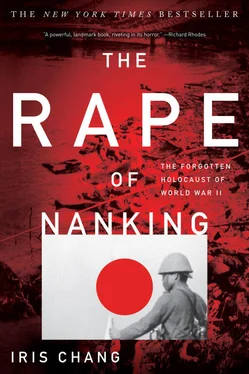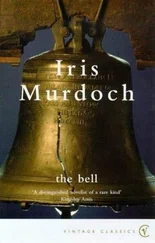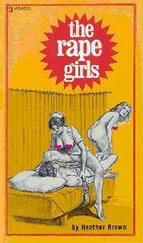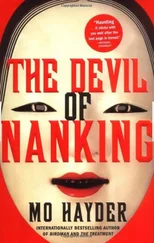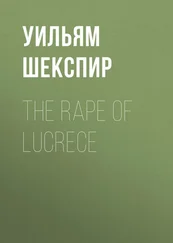But events were brewing elsewhere over which Matsui had no control. On December 5, the story goes, Prince Asaka left Tokyo by plane and arrived on the front three days later. In an abandoned country villa near field headquarters some ten miles southeast of Nanking, Prince Asaka met with General Nakajima, his colleague from his Paris days, who was now recovering from a flesh wound in his left buttock. Nakajima told Asaka that the Japanese were about to surround three hundred thousand Chinese troops in the vicinity of Nanking and that preliminary negotiations revealed that they were ready to surrender.
After Asaka heard this report, it was said that his headquarters sent out a set of orders, under his personal seal, marked “Secret, to be destroyed.” We now know that the clear message of these orders was: “KILL ALL CAPTIVES.” What is not clear is whether Asaka himself issued the orders. [2] Taisa Isamo, Asaka’s staff officer for intelligence, later confessed to friends that on his own initiative he had forged the order. Another Japanese officer, Tanaka Ryukichi, said that in April 1938, Chou, then the head of the 74th wing of the Japanese army, told him an interesting tale. Chou told him that when his troops landed at Hangchow (or Hangzhou) Bay and pushed inland, nearly 300,000 Chinese troops were cut off from retreat, so they threw away their weapons and surrendered to the Japanese. “To arrange for so many prisoners, to feed them, was a huge problem,” Chou reportedly said. As the story goes, Chou seized upon a quick-fix solution to eliminate the food problem: “I immediately issued orders to all troops: ‘We must entirely massacre these prisoners!’ Using the name of the military commander, I sent these orders by telegram. The wording of the order was to annihilate.” We will never know if this story is true, but it must be noted that even if Chou had indeed forged the kill order on his own, this does not absolve Prince Asaka of responsibility for the massacre. Asaka could have issued an order to cancel the massacre once it started and court-martialed his intelligence officer.
By the time Japanese troops entered Nanking, an order to eliminate all Chinese captives had been not only committed to paper but distributed to lower-echelon officers. On December 13, 1937, the Japanese 66th Battalion received the following command:
BATTALION BATTLE REPORTER, AT 2:00 RECEIVED ORDER FROM THE REGIMENT COMMANDER: TO COMPLY WITH ORDERS FROM BRIGADE COMMANDING HEADQUARTERS, ALL PRISONERS OF WAR ARE TO BE EXECUTED. METHOD OF EXECUTION: DIVIDE THE PRISONERS INTO GROUPS OF A DOZEN. SHOOT TO KILL SEPARATELY.
3:30 P.M. A MEETING IS CALLED TO GATHER COMPANY COMMANDERS TO EXCHANGE OPINIONS ON HOW TO DISPOSE OF POWS. FROM THE DISCUSSION IT IS DECIDED THAT THE PRISONERS ARE TO BE DIVIDED EVENLY AMONG EACH COMPANY (1ST, 2ND AND 4TH COMPANY) AND TO BE BROUGHT OUT FROM THEIR IMPRISONMENT IN GROUPS OF 50 TO BE EXECUTED. 1ST COMPANY IS TO TAKE ACTION IN THE GRAIN FIELD SOUTH OF THE GARRISON; 2ND COMPANY TAKES ACTION IN THE DEPRESSION SOUTHWEST OF THE GARRISON; AND 4TH COMPANY TAKES ACTION IN THE GRAIN FIELD SOUTHEAST OF THE GARRISON.
THE VICINITY OF THE IMPRISONMENT MUST BE HEAVILY GUARDED. OUR INTENTIONS ARE ABSOLUTELY NOT TO BE DETECTED BY THE PRISONERS.
EVERY COMPANY IS TO COMPLETE PREPARATION BEFORE 5:00. EXECUTIONS ARE TO START BY 5:00 AND ACTION IS TO BE FINISHED BY 7:30.
There was a ruthless logic to the order. The captives could not be fed, so they had to be destroyed. Killing them would not only eliminate the food problem but diminish the possibility of retaliation. Moreover, dead enemies could not form up into guerrilla forces.
But executing the order was another matter. When the Japanese troops smashed through the walls in the early predawn hours of December 13, they entered a city in which they were vastly outnumbered. Historians later estimated that more than half a million civilians and ninety thousand Chinese troops were trapped in Nanking, compared to the fifty thousand Japanese soldiers who assaulted the city. General Nakajima knew that killing tens of thousands of Chinese captives was a formidable task: “To deal with crowds of a thousand, five thousand, or ten thousand, it is tremendously difficult even just to disarm them…. It would be disastrous if they were to make any trouble.”
KILLING THE PRISONERS OF WAR
Because of their limited manpower, the Japanese relied heavily on deception. The strategy for mass butchery involved several steps: promising the Chinese fair treatment in return for an end to resistance, coaxing them into surrendering themselves to their Japanese conquerors, dividing them into groups of one to two hundred men, and then luring them to different areas near Nanking to be killed. Nakajima hoped that faced with the impossibility of further resistance, most of the captives would lose heart and comply with whatever directions the Japanese gave them.
All this was easier to achieve than the Japanese had anticipated. Resistance was sporadic; indeed, it was practically nonexistent. Having thrown away their arms when attempting to flee the city as the Japanese closed in, many Chinese soldiers simply turned themselves in, hoping for better treatment. Once the men surrendered and permitted their hands to be bound, the rest was easy.
Perhaps nowhere is the passivity of the Chinese soldiers better illustrated than in the diary of the former Japanese soldier Azuma Shiro, who described the surrender of thousands of Chinese troops shortly after the fall of Nanking. His own troops were assigning sentry and billet in a city square when they suddenly received an order to round up about 20,000 prisoners of war.
Azuma and his countrymen walked some nine or ten miles in search of the prisoners. Night fell, and the Japanese finally heard a rumbling, froglike noise. They also saw numerous cigarette lights blinking in the darkness. “It was a magnificent view,” Azuma wrote. “Seven thousand prisoners all in one place, gathering around the two white flags attached to a dead branch, which flew in the night sky.” The prisoners were a ragged assortment of men wearing blue cotton military uniforms, blue cotton overcoats, and caps. Some covered their heads with blankets, some carried mat-rush sacks, and some carried futons on their backs. The Japanese lined the prisoners up into four columns, with the white flag at the head. This group of thousands of Chinese soldiers had waited patiently for the Japanese to fetch them and direct them to the next step in the surrender process.
The reluctance of the Chinese army to fight back stunned Azuma. To a man who came from a military culture in which pilots were given swords instead of parachutes, and in which suicide was infinitely preferable to capture, it was incomprehensible that the Chinese would not fight an enemy to the death. His contempt for the Chinese deepened when he discovered that the prisoners’ numbers exceeded those of the captors.
“It was funny yet pitiable when I imagined how they gathered whatever white cloth they could find, attached it to a dead twig, and marched forward just to surrender,” Azuma wrote.
I thought, how could they become prisoners, with the kind of force they had—more than two battalions—and without even trying to show any resistance. There must have been a considerable number of officers for this many troops, but not a single one remained, all of them having slipped away and escaped, I thought. Although we had two companies, and those seven thousand prisoners had already been disarmed, our troops could have been annihilated had they decided to rise up and revolt.
A welter of emotions filled Azuma. He felt sorry for the Chinese soldiers, thirsty and frightened men who constantly asked for water and reassurance that they would not be killed. But at the same time their cowardice disgusted him. Azuma suddenly felt ashamed for ever having been secretly afraid of the Chinese in previous battles, and his automatic impulse was to dehumanize the prisoners by comparing them to insects and animals.
Читать дальше
